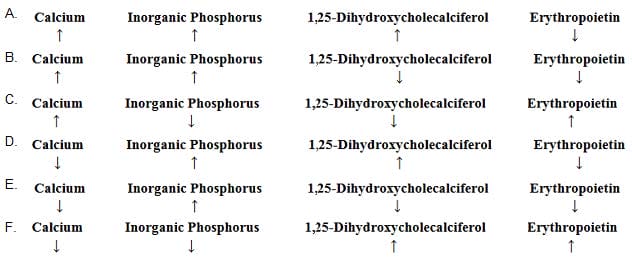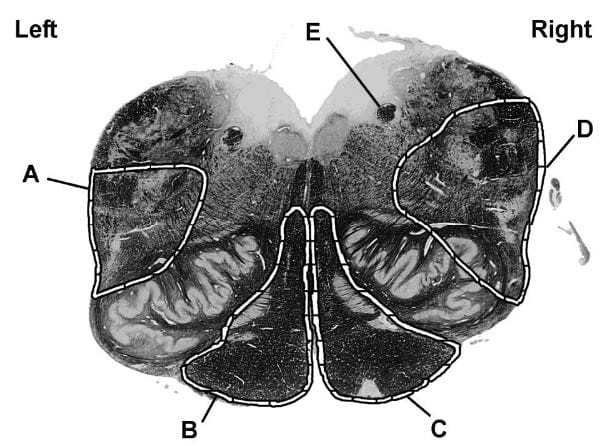Exam Details
Exam Code
:USMLEExam Name
:United States Medical Licensing ExaminationCertification
:USMLE CertificationsVendor
:USMLETotal Questions
:622 Q&AsLast Updated
:Apr 13, 2025
USMLE USMLE Certifications USMLE Questions & Answers
-
Question 491:
A previously healthy 24-year-old woman who is a college student comes to the office because of a 6month history of abdominal bloating, upper abdominal discomfort, and constipation. The symptoms are more severe when she is preparing for examinations but improve after bowel movements. She takes no medications. She does not smoke or use illicit drugs. She drinks alcoholic beverages occasionally. She is 160 cm (5 ft 3 in) tall and weighs 57 kg (125 lb); BMI is 22 kg/m2. Her pulse is 72/min, and blood pressure is 100/72 mmHg. Physical examination, including digital rectal examination, shows no other abnormalities. A complete blood count and serum electrolyte concentrations are within the reference ranges. A urease breath test result is negative. Upper and lower endoscopies show no abnormalities. Which of the following is the most appropriate pharmacotherapy for this patient?
A. Azathioprine
B. Infliximab
C. Lubiprostone
D. Mesalamine
E. Sulfasalazine
-
Question 492:
A 32-year-old man is brought to the emergency department 30 minutes after being struck by a car while driving his motorcycle. He reports severe pelvic pain. On examination, there is bruising of the perineum and pain is elicited with motion of his pelvis. Blood is noted at the urethral meatus. There is no other penile trauma. A plain x-ray shows a fracture of the superior pubic ramus and retrograde urethrography is done to evaluate for a urethral disruption. Which of the following portions of the urethra would be at greatest risk for injury in this patient?
A. Intramural (pre-prostatic)
B. Membranous
C. Prostatic
D. Spongy
-
Question 493:
A 4-year-old boy is brought to the physician because of slow growth during the past year. He has had recurrent urinary tract infections since the age of 1 year. He is at the 10th percentile for height and 25th percentile for weight. Physical examination shows pallor. Laboratory studies show a normochromic, normocytic anemia and increased serum concentrations of urea nitrogen and creatinine. Urinalysis shows a low specific gravity. Which of the following sets of additional serum findings is most likely in this patient?

A. Option A
B. Option B
C. Option C
D. Option D
E. Option E
F. Option F
-
Question 494:
A 72-year-old woman is brought to the emergency department by her husband because of a 1-hour history of difficulty walking and speaking. The husband says that she was well last night but when she awoke this morning, she had difficulty getting out of bed and her speech was slurred. She has a 20-year history of type 2 diabetes mellitus well controlled with medication and diet. She is alert and oriented and is able to follow commands and respond verbally, but she has impaired speech. Her pulse is 80/min, respirations are 16/min, and blood pressure is 142/88 mmHg. Physical examination shows left-sided hemiparesis. The tongue deviates to the right when protruded. Sensation to pinprick and temperature is normal, and proprioception and sensation to light touch are absent over the left upper and lower extremities. Which of the following labeled sites in the photograph of a cross section of a normal brain stem is most likely damaged in this patient?

A. A
B. B
C. C
D. D
E. E
-
Question 495:
A 72-year-old woman comes to the physician because of a 3-day history of fever, shortness of breath, difficulty swallowing, chest pain, and cough. She is frail. Physical examination shows tachypnea and equal pulses bilaterally. Percussion of the chest shows dullness over the right lower lung field. Laboratory studies show arterial hypoxemia and decreased PCO2. A chest x-ray shows an area of opacification in the lower region of the right lung. Which of the following is the most likely cause of this patient's condition?
A. Alveolar proteinosis
B. Aspiration
C. Cigarette smoking
D. Emphysema E. Vasculitis
-
Question 496:
A 25-year-old woman comes to the office because of a 6-month history of increasingly severe low back pain and heavy menses. Her temperature is 37.1°C (98.8°F), pulse is 75/min, respirations are 13/min, and blood pressure is 115/79 mmHg. Physical examination shows no abnormalities. An endometrial biopsy specimen shows regular tubular endometrial glands with abundant mitotic figures in the endometrial glands and stroma. Which of the following proteins or enzymes regulate the progression of cells into this phase of this patient's menstrual cycle?
A. AMP-dependent kinases
B. Cyclin-dependent kinases
C. Hexokinases
D. Lipid kinases
E. Urokinases
-
Question 497:
A new severe respiratory illness caused by a newly identified virus is discovered. Which of the following properties of a killed vaccine relative to a live vaccine is the most appropriate rationale for developing a killed vaccine for this illness?
A. Avoids the concern for reversion to virulence
B. Develops more rapid protective immunity
C. Is less likely to require subsequent boosters for lifelong immunity
D. Is most likely to generate mucosal immunity
E. Requires little safety monitoring to ensure inactivation
-
Question 498:
A 42-year-old woman comes to the physician for a routine examination. She says that she has felt well except for occasional episodes of constipation, abdominal discomfort, and mild fatigue. She was treated
for a renal calculus 10 years ago and was told she had a "lazy gallbladder." Her pulse is 82/min, and blood
pressure is 150/80 mmHg. Physical examination shows no other abnormalities. Laboratory studies show:

The most likely cause of this patient's condition is a small, well-defined nodule in which of the following locations?
A. Adrenal gland
B. Anterior pituitary gland
C. Gallbladder
D. Kidney
E. Parathyroid gland
F. Thymus
-
Question 499:
A 54-year-old man comes to the physician because of episodes of fainting for 3 months. He also has had difficulty performing daily tasks because he is easily fatigued. He had a myocardial infarction 12 years ago. His pulse is 40/min, respirations are 18/min, and blood pressure is 138/85 mmHg. Physical examination shows evidence of cannon a waves. An ECG shows a P-wave rate of 90/min, and an R-wave rate of 40/ min, with no apparent relation between the two. Which of the following is the most likely diagnosis?
A. First-degree atrioventricular block
B. Right bundle branch block
C. Second-degree atrioventricular block, type I
D. Second-degree atrioventricular block, type II
E. Third-degree atrioventricular block
-
Question 500:
A 15-year-old boy is brought to the emergency department by his parents because of a 2-hour history of confusion and agitation. He also has had fever, headache, stiff neck, and vomiting since he returned from summer camp 2 days ago. His parents say he does not use illicit drugs. On arrival, he is combative and there is evidence of hallucinations. His temperature is 40° C (104°F), pulse is 80/min, respirations are 17/ min, and blood pressure is 100/70 mmHg. A lumbar puncture is performed. Results of cerebrospinal fluid analysis show cysts and trophozoites. The most likely portal of pathogen entry into this patient's central nervous system is which of the following?
A. Cavernous sinus
B. Facial nerve
C. Frontal sinus
D. Mastoid sinus
E. Olfactory nerve
F. Trigeminal nerve
Tips on How to Prepare for the Exams
Nowadays, the certification exams become more and more important and required by more and more enterprises when applying for a job. But how to prepare for the exam effectively? How to prepare for the exam in a short time with less efforts? How to get a ideal result and how to find the most reliable resources? Here on Vcedump.com, you will find all the answers. Vcedump.com provide not only USMLE exam questions, answers and explanations but also complete assistance on your exam preparation and certification application. If you are confused on your USMLE exam preparations and USMLE certification application, do not hesitate to visit our Vcedump.com to find your solutions here.